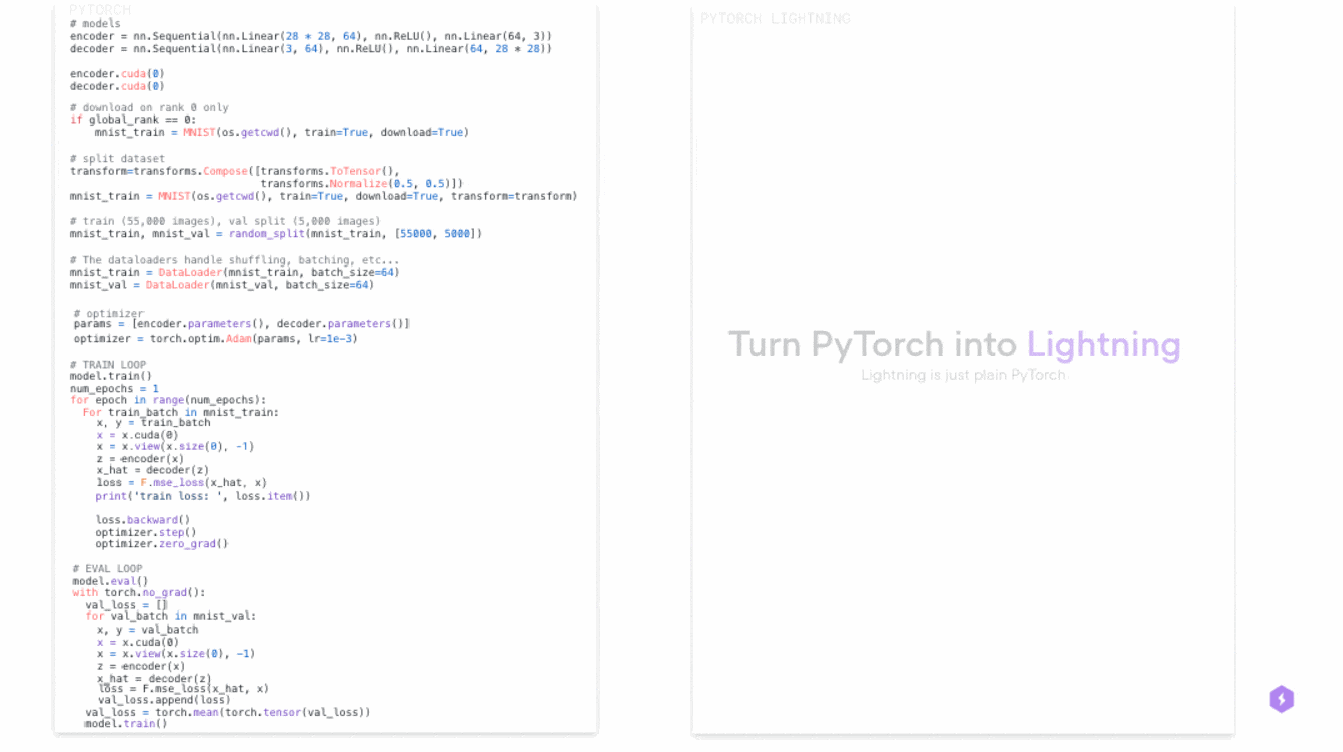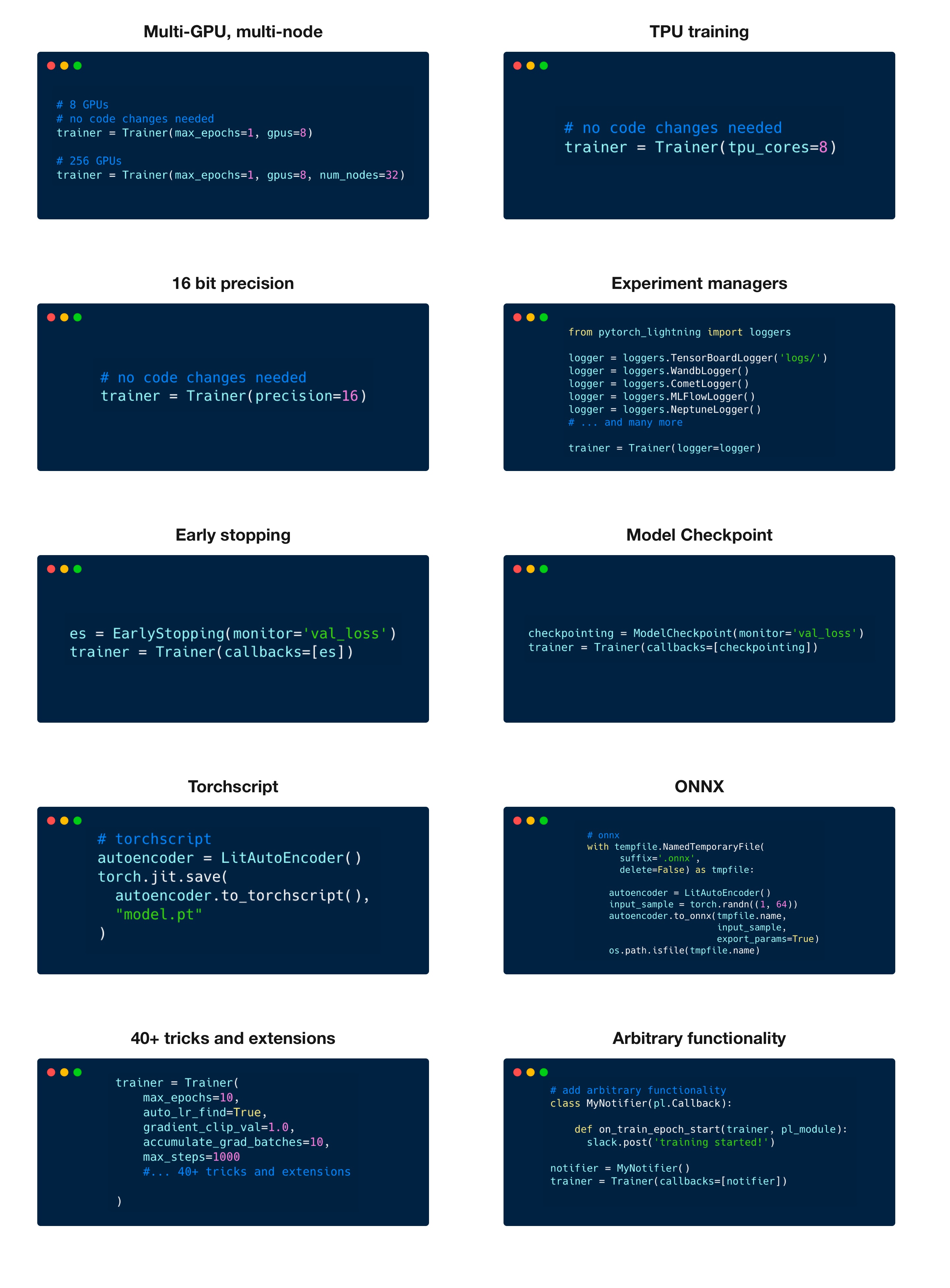
The deep learning framework to pretrain and finetune AI models.
Deploying models? Check out LitServe, the PyTorch Lightning for inference engines
Quick start • Examples • PyTorch Lightning • Fabric • Lightning Cloud • Community • Docs
Over 340,000 developers use Lightning Cloud - purpose-built for PyTorch and PyTorch Lightning.
- GPUs from $0.19.
- Clusters: frontier-grade training/inference clusters.
- AI Studio (vibe train): workspaces where AI helps you debug, tune and vibe train.
- AI Studio (vibe deploy): workspaces where AI helps you optimize, and deploy models.
- Notebooks: Persistent GPU workspaces where AI helps you code and analyze.
- Inference: Deploy models as inference APIs.
Training models in plain PyTorch is tedious and error-prone - you have to manually handle things like backprop, mixed precision, multi-GPU, and distributed training, often rewriting code for every new project. PyTorch Lightning organizes PyTorch code to automate those complexities so you can focus on your model and data, while keeping full control and scaling from CPU to multi-node without changing your core code. But if you want control of those things, you can still opt into expert-level control.
Fun analogy: If PyTorch is Javascript, PyTorch Lightning is ReactJS or NextJS.
PyTorch Lightning: Train and deploy PyTorch at scale.
Lightning Fabric: Expert control.
Lightning gives you granular control over how much abstraction you want to add over PyTorch.
Install Lightning:
pip install lightningAdvanced install options
pip install lightning['extra']conda install lightning -c conda-forgeInstall future release from the source
pip install https://github.com/Lightning-AI/lightning/archive/refs/heads/release/stable.zip -UInstall nightly from the source (no guarantees)
pip install https://github.com/Lightning-AI/lightning/archive/refs/heads/master.zip -Uor from testing PyPI
pip install -iU https://test.pypi.org/simple/ pytorch-lightningDefine the training workflow. Here's a toy example (explore real examples):
# main.py
# ! pip install torchvision
import torch, torch.nn as nn, torch.utils.data as data, torchvision as tv, torch.nn.functional as F
import lightning as L
# --------------------------------
# Step 1: Define a LightningModule
# --------------------------------
# A LightningModule (nn.Module subclass) defines a full *system*
# (ie: an LLM, diffusion model, autoencoder, or simple image classifier).
class LitAutoEncoder(L.LightningModule):
def __init__(self):
super().__init__()
self.encoder = nn.Sequential(nn.Linear(28 * 28, 128), nn.ReLU(), nn.Linear(128, 3))
self.decoder = nn.Sequential(nn.Linear(3, 128), nn.ReLU(), nn.Linear(128, 28 * 28))
def forward(self, x):
# in lightning, forward defines the prediction/inference actions
embedding = self.encoder(x)
return embedding
def training_step(self, batch, batch_idx):
# training_step defines the train loop. It is independent of forward
x, _ = batch
x = x.view(x.size(0), -1)
z = self.encoder(x)
x_hat = self.decoder(z)
loss = F.mse_loss(x_hat, x)
self.log("train_loss", loss)
return loss
def configure_optimizers(self):
optimizer = torch.optim.Adam(self.parameters(), lr=1e-3)
return optimizer
# -------------------
# Step 2: Define data
# -------------------
dataset = tv.datasets.MNIST(".", download=True, transform=tv.transforms.ToTensor())
train, val = data.random_split(dataset, [55000, 5000])
# -------------------
# Step 3: Train
# -------------------
autoencoder = LitAutoEncoder()
trainer = L.Trainer()
trainer.fit(autoencoder, data.DataLoader(train), data.DataLoader(val))Run the model on your terminal
pip install torchvision
python main.py
PyTorch Lightning is just organized PyTorch - Lightning disentangles PyTorch code to decouple the science from the engineering.
Explore various types of training possible with PyTorch Lightning. Pretrain and finetune ANY kind of model to perform ANY task like classification, segmentation, summarization and more:
| Task | Description | Run |
|---|---|---|
| Hello world | Pretrain - Hello world example |  |
| Image classification | Finetune - ResNet-34 model to classify images of cars |  |
| Image segmentation | Finetune - ResNet-50 model to segment images |  |
| Object detection | Finetune - Faster R-CNN model to detect objects |  |
| Text classification | Finetune - text classifier (BERT model) |  |
| Text summarization | Finetune - text summarization (Hugging Face transformer model) |  |
| Audio generation | Finetune - audio generator (transformer model) |  |
| LLM finetuning | Finetune - LLM (Meta Llama 3.1 8B) |  |
| Image generation | Pretrain - Image generator (diffusion model) |  |
| Recommendation system | Train - recommendation system (factorization and embedding) |  |
| Time-series forecasting | Train - Time-series forecasting with LSTM |  |
Lightning has over 40+ advanced features designed for professional AI research at scale.
Here are some examples:
Train on 1000s of GPUs without code changes
# 8 GPUs
# no code changes needed
trainer = Trainer(accelerator="gpu", devices=8)
# 256 GPUs
trainer = Trainer(accelerator="gpu", devices=8, num_nodes=32)Train on other accelerators like TPUs without code changes
# no code changes needed
trainer = Trainer(accelerator="tpu", devices=8)16-bit precision
# no code changes needed
trainer = Trainer(precision=16)Experiment managers
from lightning import loggers
# tensorboard
trainer = Trainer(logger=TensorBoardLogger("logs/"))
# weights and biases
trainer = Trainer(logger=loggers.WandbLogger())
# comet
trainer = Trainer(logger=loggers.CometLogger())
# mlflow
trainer = Trainer(logger=loggers.MLFlowLogger())
# neptune
trainer = Trainer(logger=loggers.NeptuneLogger())
# ... and dozens moreEarly Stopping
es = EarlyStopping(monitor="val_loss")
trainer = Trainer(callbacks=[es])Checkpointing
checkpointing = ModelCheckpoint(monitor="val_loss")
trainer = Trainer(callbacks=[checkpointing])Export to torchscript (JIT) (production use)
# torchscript
autoencoder = LitAutoEncoder()
torch.jit.save(autoencoder.to_torchscript(), "model.pt")Export to ONNX (production use)
# onnx
with tempfile.NamedTemporaryFile(suffix=".onnx", delete=False) as tmpfile:
autoencoder = LitAutoEncoder()
input_sample = torch.randn((1, 64))
autoencoder.to_onnx(tmpfile.name, input_sample, export_params=True)
os.path.isfile(tmpfile.name)- Models become hardware agnostic
- Code is clear to read because engineering code is abstracted away
- Easier to reproduce
- Make fewer mistakes because lightning handles the tricky engineering
- Keeps all the flexibility (LightningModules are still PyTorch modules), but removes a ton of boilerplate
- Lightning has dozens of integrations with popular machine learning tools.
- Tested rigorously with every new PR. We test every combination of PyTorch and Python supported versions, every OS, multi GPUs and even TPUs.
- Minimal running speed overhead (about 300 ms per epoch compared with pure PyTorch).
Run on any device at any scale with expert-level control over PyTorch training loop and scaling strategy. You can even write your own Trainer.
Fabric is designed for the most complex models like foundation model scaling, LLMs, diffusion, transformers, reinforcement learning, active learning. Of any size.
| What to change | Resulting Fabric Code (copy me!) |
|---|---|
+ import lightning as L
import torch; import torchvision as tv
dataset = tv.datasets.CIFAR10("data", download=True,
train=True,
transform=tv.transforms.ToTensor())
+ fabric = L.Fabric()
+ fabric.launch()
model = tv.models.resnet18()
optimizer = torch.optim.SGD(model.parameters(), lr=0.001)
- device = "cuda" if torch.cuda.is_available() else "cpu"
- model.to(device)
+ model, optimizer = fabric.setup(model, optimizer)
dataloader = torch.utils.data.DataLoader(dataset, batch_size=8)
+ dataloader = fabric.setup_dataloaders(dataloader)
model.train()
num_epochs = 10
for epoch in range(num_epochs):
for batch in dataloader:
inputs, labels = batch
- inputs, labels = inputs.to(device), labels.to(device)
optimizer.zero_grad()
outputs = model(inputs)
loss = torch.nn.functional.cross_entropy(outputs, labels)
- loss.backward()
+ fabric.backward(loss)
optimizer.step()
print(loss.data) |
import lightning as L
import torch; import torchvision as tv
dataset = tv.datasets.CIFAR10("data", download=True,
train=True,
transform=tv.transforms.ToTensor())
fabric = L.Fabric()
fabric.launch()
model = tv.models.resnet18()
optimizer = torch.optim.SGD(model.parameters(), lr=0.001)
model, optimizer = fabric.setup(model, optimizer)
dataloader = torch.utils.data.DataLoader(dataset, batch_size=8)
dataloader = fabric.setup_dataloaders(dataloader)
model.train()
num_epochs = 10
for epoch in range(num_epochs):
for batch in dataloader:
inputs, labels = batch
optimizer.zero_grad()
outputs = model(inputs)
loss = torch.nn.functional.cross_entropy(outputs, labels)
fabric.backward(loss)
optimizer.step()
print(loss.data) |
Easily switch from running on CPU to GPU (Apple Silicon, CUDA, …), TPU, multi-GPU or even multi-node training
# Use your available hardware
# no code changes needed
fabric = Fabric()
# Run on GPUs (CUDA or MPS)
fabric = Fabric(accelerator="gpu")
# 8 GPUs
fabric = Fabric(accelerator="gpu", devices=8)
# 256 GPUs, multi-node
fabric = Fabric(accelerator="gpu", devices=8, num_nodes=32)
# Run on TPUs
fabric = Fabric(accelerator="tpu")Use state-of-the-art distributed training strategies (DDP, FSDP, DeepSpeed) and mixed precision out of the box
# Use state-of-the-art distributed training techniques
fabric = Fabric(strategy="ddp")
fabric = Fabric(strategy="deepspeed")
fabric = Fabric(strategy="fsdp")
# Switch the precision
fabric = Fabric(precision="16-mixed")
fabric = Fabric(precision="64")All the device logic boilerplate is handled for you
# no more of this!
- model.to(device)
- batch.to(device)Build your own custom Trainer using Fabric primitives for training checkpointing, logging, and more
import lightning as L
class MyCustomTrainer:
def __init__(self, accelerator="auto", strategy="auto", devices="auto", precision="32-true"):
self.fabric = L.Fabric(accelerator=accelerator, strategy=strategy, devices=devices, precision=precision)
def fit(self, model, optimizer, dataloader, max_epochs):
self.fabric.launch()
model, optimizer = self.fabric.setup(model, optimizer)
dataloader = self.fabric.setup_dataloaders(dataloader)
model.train()
for epoch in range(max_epochs):
for batch in dataloader:
input, target = batch
optimizer.zero_grad()
output = model(input)
loss = loss_fn(output, target)
self.fabric.backward(loss)
optimizer.step()You can find a more extensive example in our examples
Lightning is rigorously tested across multiple CPUs, GPUs and TPUs and against major Python and PyTorch versions.
Current build statuses
| System / PyTorch ver. | 1.13 | 2.0 | 2.1 |
|---|---|---|---|
| Linux py3.9 [GPUs] | |||
| Linux (multiple Python versions) | |||
| OSX (multiple Python versions) | |||
| Windows (multiple Python versions) |
The lightning community is maintained by
- 10+ core contributors who are all a mix of professional engineers, Research Scientists, and Ph.D. students from top AI labs.
- 800+ community contributors.
Want to help us build Lightning and reduce boilerplate for thousands of researchers? Learn how to make your first contribution here
Lightning is also part of the PyTorch ecosystem which requires projects to have solid testing, documentation and support.
If you have any questions please:









